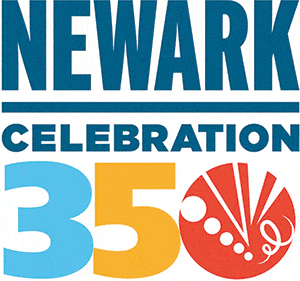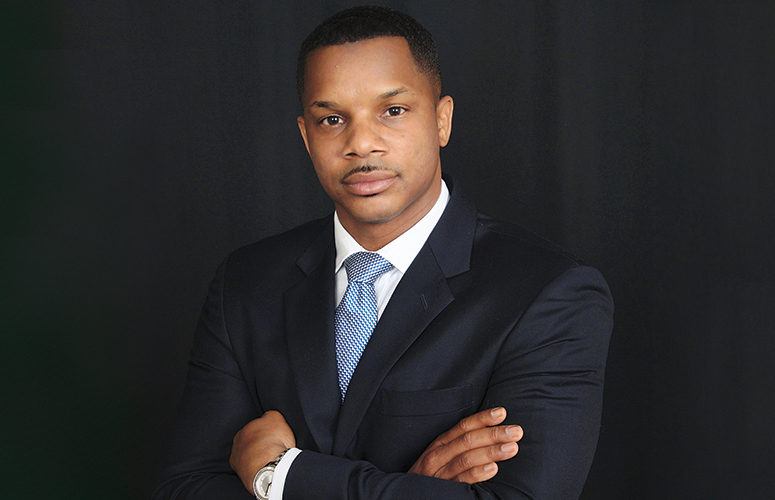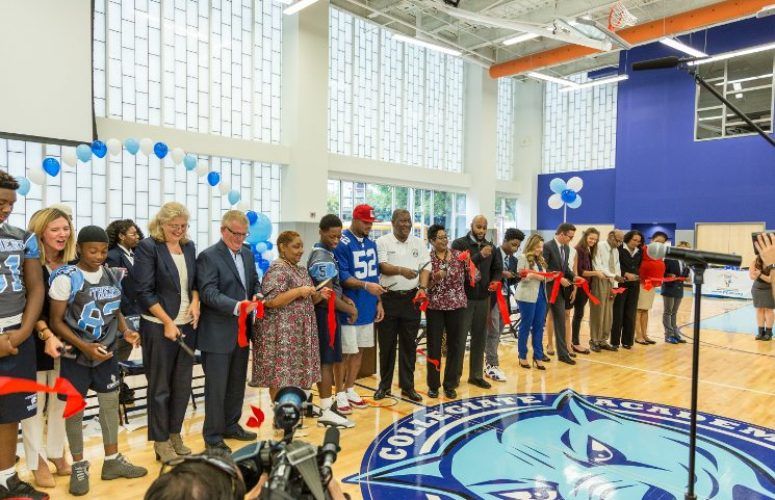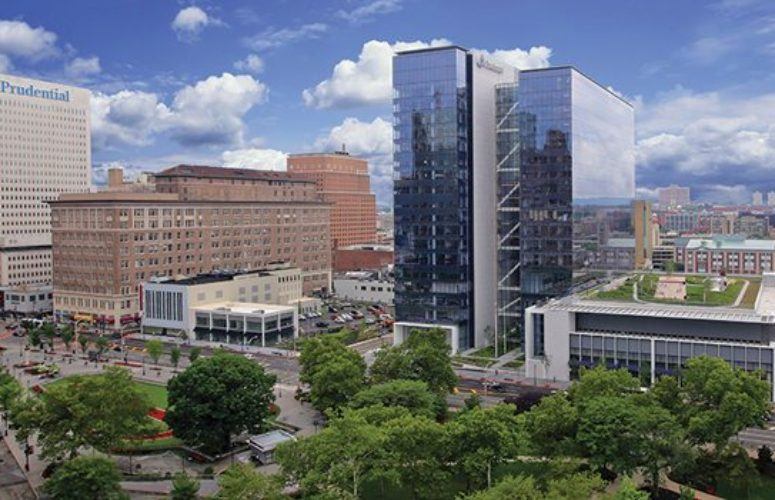
Newark Celebrates 350 Years
Partners help overcome stigma of 1967 riots in state’s largest city.
By Anthony Birritteri, Editor-in-Chief On Aug 29, 2016Standing on the corner of Broad Street and Prudential Drive during the middle of a summer workweek, one sees the thriving city Newark has become. On the sidewalks, diverse populations are walking to or from their jobs, whether in corporate high-rise office buildings or smaller retail shops that line the city’s main avenues.
Military Park, across the street from Prudential Financial’s new 20-story complex, is filled with Newark residents and employees who are enjoying their lunches, taking exercise classes, having a drink at the café, playing serious “ping pong” or simply enjoying the sights and sounds of a metropolis that has crossed the threshold of decay to urban renewal since the riots of 1967, which had left 26 people dead.
For Chip Hallock, who for 17 years, has been with the Newark Regional Business Partnership (NRBP), the metamorphosis at Military Park is evidence enough that Newark has changed. “No one wanted to walk through the park a couple of years ago. Now, people are much more comfortable being out on the street, and there’s a buzz when you go to new places to eat, like the recently opened Redd’s Biergarten,” he says. This is Redd’s second location in the city, occupying 7,000 square feet of space at 218 Market Street near the Prudential Center.
“If you look out of my office window in any direction, you can point to substantial things that have happened in Newark over the last 15 to 20 years,” the NRBP president and CEO continues. “Sometimes it has been baby steps, but Newark didn’t go downhill overnight, so the climb back up has been slow and difficult, but the momentum is picking up.”
Newark Celebration 350
This is excellent news, since Newark is in the midst of celebrating its 350th anniversary. City residents are proud of their communities, no matter which of the five wards they live in. No one perhaps knows about this pride better than Junius Williams, chair of Newark Celebration 350 (NC350). Currently the director of the Abbot Leadership Institute at Rutgers University – Newark, Williams is an attorney, author, educator, musician and lifelong advocate for Newark residents.
He was in Newark during the six days of what he calls “The Newark Rebellion,” which occurred from July 12-17, 1967. The cause of the riot was social unrest in the African-American community over police racial profiling, the lack of educational opportunities and jobs, and what Williams says was a major cause: the proposed plan by the state to take 150 acres in the Central Ward from residents for the location and creation of the planned University of Medicine & Dentistry of New Jersey.“I was scared because I didn’t want to be killed, I was mad because they (police) were getting away with what they did, and I was sad because of the destruction,” Williams recalls. Yet, “I was also glad because in the rebellion’s aftermath, we were able to get the people engaged in an empowerment process that led to the medical school being reduced in size, with people getting jobs and housing. We were glad that the power structure saw that it was to everybody’s best interest to build housing and create jobs.”
Almost 50 years later, the 72-year-old says, “I am pleased with what Newark has become. I have watched the people grow in terms of their own ability to look at and wrestle with the issues, apply their skills and make a better life for themselves.
“I am also pleased with the potential Newark has, but we have a long way to go in terms of being the city that everyone can enjoy and benefit from in terms of education, jobs, transportation and recreation … all of these things are coming to Newark, but my objective is to see that more people benefit from the economic and political engine Newark has become,” he says.
As head of Newark Celebration 350, Williams is overseeing a year-long jubilee of events and festivities marking the city’s anniversary. More than 150 programs are highlighting Newark’s rich history, achievements, diverse communities and culture. A major two-day event, the 350 Founders Weekend Festival, was held in mid-May. Thousands of people came from within Newark and from the city’s outskirts to see Grammy award-winning artist and Newark native Faith Evans perform at Newark Symphony Hall. Naughty by Nature, Cissy Houston with the Jubilation Gospel Choir, and other musical acts performed on sbsequent days at Military Park. Much more is planned throughout the year, and a list of events can be found at www.nc350.org.
At press-time, NC350 is close to raising $3 million for its events. It has been receiving tremendous support from Newark’s corporate partners, including Public Service Enterprise Group (PSEG) and Prudential, plus the Victoria Foundation, all of which have contributed $250,000 or more, each. Active on the NC350 committee are: PSEG Chairman Ralph Izzo; John Schreiber, president and CEO of the New Jersey Performing Arts Center (NJPAC); Shane Harris, vice president of the Prudential Foundation; and Irene Cooper-Basch, executive officer of the Victoria Foundation.
NC350 got all of Newark’s five wards involved in the program by creating ward committees. “We did this to find out what the people wanted to celebrate,” Williams explains. “We wanted them to come up with a concept of what and who should be celebrated. The events should be musical, cultural and intellectual.”
NRBP’s Hallock says that Williams is the perfect person to head NC350 because “he knows the city so well and has such an affection for it.”
Just as Williams would like to see more opportunity for Newark residents, so does Mayor Ras Baraka.
According to Hallock, “The mayor is very determined for the entire city to move forward, not just the downtown. He is determined to see neighborhoods come back. He understands that there has to be a match between Newark’s employer needs and the skill sets of Newark residents. He is also placing pressure on employers to make a special effort to hire Newark residents when possible.”
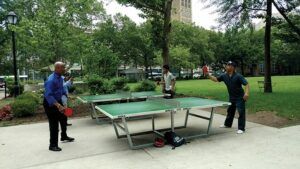
Newarkers enjoying a game of ping pong at Military Park. After many years as an underutilized space, Military Park now attracts children, adults, local residents, office workers and students to the city’s revitalized town square.
Population and Housing Increases
Newark has a population of 277,140 residents, based on 2010 US Census results. An increase of 3,600 residents from the 2000 census, this was the first time the city’s population grew in three decades. Data from ESRI, a geographic information software company that tracks population, also reveals that by 2018, the city will have 278,436 residents. Meanwhile, the North Jersey Transportation Planning Authority forecasts that by 2020, Newark will have about 303,000 residents.
Hallock says that much of this growth has to do with the trend towards downtown living and the desire of Millennials to live in 24/7 urban environments with major mass transit offerings. “If you walk along Market Street, old retail space and the small offices that were above them, that have been vacant for decades, are turning into very nice apartments,” he says. Some of the recent housing projects he mentions in the downtown include the $150-million Teachers Village on Halsey Street, which consists of 205 residential units (studio and one- to three-bedroom units), 65,000 square feet of retail space, three charter schools and a daycare facility. The RBH Group is the lead developer in this mixed-use project, which is financed through a consortium of private and public investments and government tax credits.
There is also the 400,000-square-foot Hahne & Co. Building on Broad Street that L+M Development Partners (along with Rutgers University, Prudential Financial, Goldman Sachs, Citigroup and municipal and state agencies) is converting into a mixed-use facility that will include apartments, an arts and cultural center for Rutgers University, a Whole Foods store and other retailers on the ground level. According to Hallock, it will contain 170 housing units.
NBA legend Shaquille O’Neal and New Brunswick-based Boraie Development are building the city’s first high-rise apartment in more than 50 years: a former Science High School building that is being converted into a 23-story, 169-unit apartment tower with retail space on the ground floor.
At the New Jersey Performing Arts Center (NJPAC), construction will start later this summer for One Theater Square, a 22-story residential tower opposite the Arts Center. It will house 245 market-rate luxury apartments and retail establishments. NJPAC is working with Dranoff Properties on this project.
Other downtown housing developments include RockPlaza Lofts (80 units); Eleven80 (317 units); Studebaker Lofts (68 units) and Packard Lofts (28 units). In the city’s University Heights neighborhood, Tucker Development recently opened 24 Jones, a 152-unit apartment complex.
The Business Landscape
Though businesses and people outside of Newark may still hold negative views of the city – a lingering effect of the 1967 riots – the facts prove that the city is a thriving center of commerce. There are more than 50 Fortune 500 companies with operations in the city. Additionally, there is a highly skilled labor pool of more than 1.7-million residents in the Greater Newark region. With six colleges and universities located within walking distance of the central business district, including Rutgers University – Newark, the New Jersey Institute of Technology, Essex County College, Seton Hall Law School, Berkeley College and Pillar College, there is always a highly skilled graduating workforce ready to be employed at area businesses. In total, 55,000 students attend higher education institutions in Newark.
There are many stories to tell about businesses in Newark. NRBP’s Hallock comments that no matter whom he talks to, he often hears stories of how people started their professional careers in the city or recall shopping at the Hahne’s building and other major department stores in town.
Of course, some business left the city after the 1967 riots, but many others have remained and grown. Additionally, new businesses and sports and entertainment venues have moved in over the years, while institutions of higher education keep on expanding.
Here are some of their interesting Newark stories:
McCarter & English
This regional law firm, with nine offices stretching from Boston to Washington, DC, maintains its roots in Newark. The firm was founded by Thomas N. McCarter in Sussex County, who moved his family and law practice to Newark in 1865.
The history of the McCarter family is inextricably tied to the modern history of Newark. The founder’s son, Robert H. McCarter, served as a state Attorney General. His younger brother, Thomas N. McCarter, Jr., for whom the Newark segment of Route 21 is named, also served as a judge, a member of the New Jersey Senate and a New Jersey Attorney General, and went on to found what is now Public Service Electric & Gas Company (PSE&G). A third brother, Uzal McCarter, founded and led what became First Fidelity Bank.
The firm continues to contribute to the growth of Newark by providing legal services to the city’s varied business, educational, healthcare and institutional cornerstones. As the oldest continuing member of the Newark legal community, the firm represents and collaborates with legacy Newark giants like Prudential and Rutgers University as well as cutting-edge startups in the tech-, tech-enabled and life sciences sectors in and around Newark.
The firm employs 339 people, including paralegals, support staff and 178 attorneys, at its Newark office.
Public Service Enterprise Group
The Public Service Corporation, formed in Newark in 1903, was the amalgamation of more than 400 gas, electric and transportation companies in New Jersey. Today known as Public Service Enterprise Group (PSEG), the company has maintained Newark as its headquarters ever since, where 1,679 employees currently work. Approximately 159 employees live in the city.
Over the years, PSEG has worked to support Newark’s economic health. Each year, the company spends money with local Newark businesses, including $89 million of goods and services in 2015. Over the last five years, PSEG has contributed nearly $17 million to Newark-based charities and organizations.
In celebration of Newark’s 350th, PSEG and the PSEG Foundation have committed more than $500,000 to organizations and events throughout the city that celebrate the richness of Newark’s history and residents.
The company is also investing heavily in making sure that Newark has the gas and electric infrastructure that benefits customers, supports the city’s growth and creates local jobs. Most recently, it renewed its lease at its corporate headquarters, located at 80 Park Plaza, committing to remain in the city for the foreseeable future.
Horizon BCBS
For the past 84 years, Horizon Blue Cross Blue Shield of New Jersey has been a proud Newark supporter. The health insurance company’s relationship with the city dates back to 1932, when the Associated Hospitals of Essex County was incorporated as the first multi-hospital prepaid health plan in Newark. It would later become one of the first Blue Cross plans in the nation.
Almost 2,800 of Horizon’s 5,000 employees work at its Newark headquarters. These and all of its employees are committed to supporting Newark. For example, Horizon and The Horizon Foundation for New Jersey have invested more than $2.1 million in foundation grants to Newark-based non-profit organizations in 2015 and the first half of 2016. Since 2004, Horizon BCBS and The Foundation have invested more than $19.2 million in contributions to Newark-based nonprofit organizations. Recently, it provided a $200,000 grant to support Newark Celebration 350.
According to the company, “Newark is our home. It is not only New Jersey’s largest city, but it is also among the most diverse. Horizon BCBS takes pride in our commitment to diversity and inclusion among our employees, members, physicians and business partners. We embrace and value differences of culture, education, experience, physical ability and unique perspectives in our workplace.”
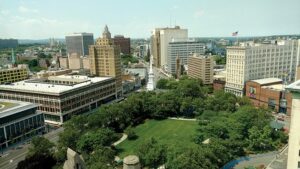
A skyline view looking north onto Broad Street. The former Hahne & Co. department store building is center, while Military Park is lower right. L+M Development Partners, along with Rutgers University, Prudential Financial, Goldman Sachs, Citigroup and municipal and state agencies, is converting the Hahne building into a mixed-use facility that will include apartments, an arts and cultural center for Rutgers University, a Whole Foods store and other retailers on the ground level.
Prudential Financial
Prudential Financial was founded by John Fairfield Dryden in downtown Newark, in 1875. Dryden and the company had a clear sense of purpose: to give working families a way to protect their financial well-being by providing access to affordable insurance.
The company’s headquarters has remained in Newark for 140 years, where it employs 9,357 in the city. It officially opened its new office tower last year at 655 Broad Street. The 740,000-square-foot, 20-story building is the workplace for nearly 3,000 Prudential employees. The tower is located two blocks from Prudential’s global corporate headquarters at 751 Broad Street and three blocks from its Washington Street building. The facility preserved 2,400 jobs downtown and created 400 new full-time jobs. Additionally, the tower was built by a labor force that included Newark residents and supplies that were procured from local businesses.
Since its founding, the company has invested almost $400 million throughout Newark. It has made significant grants to enhance civic infrastructure, such as the construction of the New Jersey Performing Arts Center, the redevelopment of the historic Hahne & Co. building (an almost $50-million investment) and the revitalization of Military Park (more than $2.5 million to support the park’s restoration and operations). To boost the economy and job market, it has also made investments in companies such as AeroFarms and new startup accelerator, Newark Venture Partners. To improve educational outcomes for Newark students, it has also supported charter schools.
The company also committed more than $5 million in redevelopment area bonds to support the conversion of the former National State Bank building into Hotel Indigo Newark, a 106-room boutique hotel.
According to the company, “We’ve stayed in Newark through good times and bad, making long-term investments because we know that meaningful change takes time. We have the patience and commitment it takes to really make a difference.”
Panasonic
In 2013, Panasonic Corporation of North America relocated its headquarters from a corporate park in Secaucus to a newly developed office tower in Newark: Two Riverfront Plaza. This 12-story, 340,000-square-foot location is the hub of the company’s US branding, marketing, sales, service and R&D operations. The decision to stay in New Jersey allowed the company to maintain its existing workforce without displacing nearly 800 employees.
The new headquarters, which uses Panasonic’s own lighting technology, as well as solar and vent fan technology solutions, achieved both gold and platinum LEED certification – the first new office tower in Newark to do so. The property is a joint development of SJP Properties and Matrix Development Group.
Since moving to Newark, Panasonic continually strives to be a good corporate citizen to the city. Within the first year alone, it spent nearly $2 million on area hotels, restaurants and entertainment, not including daily purchases made by employees and visitors.
Panasonic is actively engaged in the city’s revitalization efforts. Its employees are actively involved in various business and non-profit organizations. In addition, it offers volunteer opportunities to encourage employee engagement in the community. It has participated in neighborhood clean-ups, hosted e-waste events, and won an award from the Greater Newark Conservancy for its urban gardening volunteer efforts.
Panasonic is also actively involved in the city’s higher education community. It provides scholarship, internship and co-op opportunities specifically for Newark college students.
Recently, Panasonic contributed approximately $1 million in broadcast and production equipment to further strengthen the New Jersey Performing Arts Center’s position as a leader in broadcast innovation and transform NJPAC into a world-class broadcast center. The initiative supports education in the arts, distance learning, and will help NJPAC generate new revenue streams, which create long-term benefits for the city of Newark and the state of New Jersey.
NJIT
The New Jersey Institute of Technology (NJIT) has a rich history, with its beginnings developing in the industrial age of the late 19th century, when Newark’s factories churned out thread, metals, paints and leather goods. What first opened as the Newark Technical School on Feb. 9, 1885, and later became the Newark College of Engineering, has evolved into an institution that today is one of the nation’s premier polytechnic universities, with over 11,325 students.
The institute’s annual economic impact on the city is about $635.7 million, supporting roughly 4,583 jobs, and increasing the city’s tax revenues by $2.5 million each year. The school also provides Newark with educational and training opportunities, needed partnerships and facility use. The school has 1,334 full-time employees and annually employs 130 adjuncts, 232 teaching assistants and 1,059 student employees.
NJIT conducts over $110 million in research and has over $1 billion in capital assets. Its campus has grown, helping to spur development in Newark’s University Heights region. Its administration, faculty and staff serve on many planning and development organizations within the city. For example, NJIT President Joel S. Bloom is currently the chair of the University Heights Science & Technology Park, which has led to: the development of the Science Park High School; the building of NJIT incubator buildings and the Center for Public Health Research Institute of Rutgers Biomedical and Health Sciences University; and, most recently, a new building for BioTrials, a French clinical trials company.
Currently, NJIT is undertaking $300 million in campus construction, much of which uses local workers. NJIT is also working with the city, and industry partners, e.g., Panasonic, to help develop Newark as a “smart city” to integrate technology into the functioning of the city as well as to create high and low tech jobs.
The school is also the designated redeveloper for an 18-acre, $1-billion “Gateway” mixed-use project adjacent to its campus. The project includes housing, commercial, retail, parking and green spaces.
Rutgers University – Newark
Rutgers University – Newark (RU-N) has been a part of Rutgers since 1946. Before that, it was the University of Newark, founded in 1936 from a collection of stand-alone colleges that each had its own domain of interests – New Jersey Law School, Seth Boyden School of Business, and the Newark Institute of Arts and Sciences. Today, RU-N has an enrollment of 7,700 undergraduate and 4,000 graduate and professional students. The school has a faculty of 960 and staff of 780.
The RU-N strategic plan entails developing the school’s role as an anchor institution in Newark. Virtually all of its projects aim to spur economic growth directly or indirectly in the city. Examples include:
A partner in, and coordinating hub for, the Newark City of Learning Collaborative (NCLC). NCLC comprises more than 60 organizations, including higher education (RU-N, Essex County College and NJIT), coordinated through the Joseph C. Cornwall Center for Metropolitan Studies at RU-N. NCLC commits to increasing the percentage of Newark residents with postsecondary degrees from 13 percent to 25 percent by 2025.
A new financial aid initiative, called the Talent & Opportunity Pathways program – or RU-N to the TOP, is expected to make college more affordable for wide swaths of New Jersey students, especially residents of Newark, those transferring from county colleges, and those with great potential to make an impact on the world.
Express Newark (EN), opening in early 2017, which is part of a multi-functional project in Newark’s Hahne & Co. building. EN will activate 50,000 square feet of the massive 500,000-square-foot building.
A major new project in the works is the 320,000-square-foot Honors Living-Learning Community. RU-N has joined with RBH Group to create a state-of-the-art learning and residence facility with dining, recreational and academic spaces that will host upwards of 400 undergraduate students. The approximately $70-million, 400-bed community will be a mixed-use development that will include residences, classrooms/work spaces, street level retail and parking as well as a vibrant, open space that will be a gathering place for RU-N and the surrounding community. Construction is expected to begin in late 2016 and be completed in 2018.
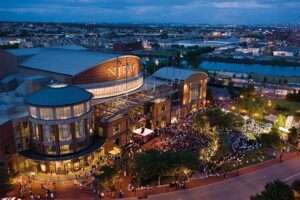
More than 10 million people have attended events at the New Jersey Performing Arts Center (NJPAC) since it opened on October 18, 1997. More than 1.5-million New Jersey students have experienced arts learning activities either in its spaces or classrooms, through NJPAC residencies.
NJPAC
The New Jersey Performing Arts Center (NJPAC) started in 1986 as a grand plan, a belief voiced by then-Governor Thomas Kean that the state deserved its own world-class performing arts center. Ultimately, it was decided there was no better place for a New Jersey arts center to take root than in downtown Newark. NJPAC’s founders envisioned a building that would not only host the world’s greatest performers, but also act as a catalyst for revitalizing the city.
More than 10 million people have attended events at the center and more than 1.5 million New Jersey students have experienced arts learning activities either in its spaces or classrooms, through NJPAC residencies.
The center has hosted visits by two US Presidents, the Dalai Lama, First Lady Michelle Obama and recently presidential candidate Hillary Clinton, who spoke at the taping of BET’s Black Girls Rock! awards. It is the home of the Geraldine R. Dodge Poetry Festival, North America’s largest poetry festival; and presents the free outdoor Horizon Foundation Sounds of the City concert series, which brings thousands to downtown Newark every Thursday evening in the summertime. NJPAC President and CEO John Schreiber is especially proud of the TD James Moody Jazz Festival, which celebrates five years this autumn at NJPAC.
The center has 125 full-time and 300 part-time employees, including ushers, stage hands, security and operational personnel.
To be the most diverse presenter in New Jersey, NJPAC has created partnerships with community leaders, radio stations, local consulates, and non-profits. Newark Mayor Ras Baraka hosts Believe in Newark, a series of town hall discussions on issues affecting residents, and NJPAC collaborates with New Jersey Symphony Orchestra, WBGO Jazz 88.3 FM and the Institute of Jazz Studies at Rutgers – Newark, to name a few.
In addition, members of NJPAC’s senior leadership serve on city-based boards, including Newark Arts Council, Downtown Newark Association, The Newark Trust for Education, Newark Celebration 350 and the Greater Newark Convention & Visitors Bureau.
Prudential Center
Prudential Center opened its doors in 2007 and is home to the three-time Stanley Cup Champion New Jersey Devils of the National Hockey League as well as Seton Hall Men’s Basketball and more than 175 concerts, family shows, graduations and other events each year. According to Hugh Weber, president of Prudential Center and the New Jersey Devils, “We want the center to be Newark’s town hall, where fans, graduates, partners and community members come together to celebrate everything that is good about New Jersey.”
The center is one of the main drivers of consumers to Newark, opening its doors to over 1.75 million people each year. “The Rock,” as it is also known, has helped shine a spotlight on the Newark community by hosting major national events, including Super Bowl Media Day, the NBA and NHL drafts, NCAA college basketball’s East Regional games, the Special Olympics USA Games Opening Ceremonies, Governor Chris Christie’s inaugural gala and a rally by President Barack Obama.
Prudential Center and the Devils employ approximately 240 full-time employees and 200 event-related staff. “We are proud to say that 60 percent of our event staff resides in Newark,” Weber says.
To celebrate the 350th Anniversary of Newark, the center will be distributing 35,000 event tickets to Newark residents throughout the year. Visit PruCenter.com/Newark350 for additional information.
“We are honored and thrilled to celebrate this occasion side by side with everyone who has ever called Newark home,” Weber says. “Our loyalty to the people that make up this city is unwavering and our commitment to its continued success is the foundation of who we are.”
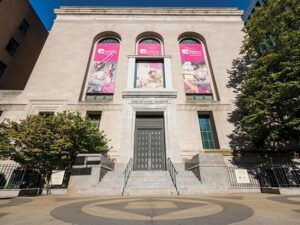
The front entrance of The Newark Museum. Incorporated in 1909, the museum opened at its current location in Washington Park in 1926. It is now engaged in a $5.5-million capital project to reopen its main entrance on Washington Street after nearly two decades.
The Newark Museum
The Newark Museum is the largest museum in the state and the 12th largest art museum collection in North America. It was incorporated in 1909 by founding director John Cotton Dana, with galleries on the top floor of the Newark Public Library for art and science exhibitions. In 1926, the museum opened in its current location on Washington Park in a facility funded by Newark department store magnate and philanthropist Louis Bamberger. What started out as a museum of, by, and for Newark quickly grew into one America’s largest and most influential museums.
“The Newark Museum has been a cultural and educational anchor for Newark and the state of New Jersey since its founding. It has served as a magnet for visitors, a cultural amenity for residents, and is an important place of stability for the community,” says CEO Steven Kern.
The museum is best known, at home and across the country, for its educational and school programs that serve more than 100,000 children and their families each year. It is a national leader in early childhood programming and its service extends through higher education to lifelong learning, senior programs, and health and wellness through the arts.
To celebrate the city’s anniversary, the museum is presenting several special exhibitions, including: Newark – Maker City; Newark Stories – Four Newarkers Who Made a Difference; and Modern Heroics – 75 Years of African-American Expressionism at the Newark Museum. Special programs have also been woven into the museum’s regular summer offerings including Jazz in the Garden (now in its 51st year) and the Newark Black Film Festival (now in its 42nd year).
The museum is currently engaged in a $5.5-million capital project to reopen its main entrance on Washington Street after nearly two decades. It will leverage its location on Washington Park and reconnect with sidewalk life that expanded greatly with the move of the Rutgers Business School to 1 Washington and the arrival of Audible in the neighborhood.
The Berger Organization
The Berger Organization is celebrating a Newark milestone in 2016 – 40 years of involvement in the city. The company purchased its first property here on March 3, 1976 with the acquisition of the Newark Holiday Inn (today a three-acre mixed-use redevelopment site) from New England Mutual Life Insurance Company. “In fact, on March 5 of that year, Mayor Kenneth Allen Gibson invited my brother, Bruce, my father, Nathan, and me to city hall to welcome our family to Newark,” recalls Miles Berger, chairman and CEO.
“We have continued to grow our Newark holdings over the years. Our portfolio today includes the Best Western Robert Treat Hotel, which is celebrating its 100th anniversary, and the Robert Treat Center (50 Park Place), the office property where we maintain our headquarters,” he says. “Our additional local office assets include the Military Park Building (60 Park Place), 58 Park Place, the Fireman’s Insurance Company Building (10 Park Place) and 570 Broad Street.”
The Berger Organization was among the companies that remained and persevered in the city after the 1967 riots.
“As Newark began its rebound in the early 1990s, the Berger family and our properties were at the forefront of the community-building efforts that fostered that progress. We take pride in having anticipated the city’s revitalization as a destination of choice for business, shopping, dining, entertainment, sports and culture, and we remain involved in projects and programs that support Newark’s future,” Berger says.
Active in the Newark community, Berger serves as the mayor-appointed chairman of the Newark Holocaust Commission. He is on the board of: the Military Park Partnership and the Greater Newark Visitors and Convention Bureau.
Genova Burns
In 2008, the law firm of Genova Burns LLC joined with Marc Berson of Fidelco in the latter’s North Broad Street Area Redevelopment efforts. At that time, the firm positioned itself in New Jersey’s urban core at 494 Broad Street. “We are proud to have served as the anchor for the building’s economic viability and as its major tenant and part owner, providing the security to allow for its expansion,” says Manager Partner Brian W. Kronick.
The firm, with 86 employees in its Newark office, represents many of the city’s anchor institutions, corporations and universities in different transactions that have – in one way or another – bolstered growth and development in the city.
As for community involvement, the firm sits on numerous boards conducive to Newark’s growth, culture and vitality. These include: The Newark Regional Business Partnership, Leadership Newark, Boys and Girls Club, and the Scholarship for Inner City Kids, just to name a few.
Gibbons PC
The law firm of Gibbons PC was founded in Newark by Andrew Crummy in 1926. It has maintained its headquarters at various locations in Newark for its entire history, most recently in Riverfront Plaza and, currently, Gateway Center (a 100,000-square-foot facility which it moved into in 2007). Some 257 people currently work at its headquarters, and a substantial portion of them live in Newark.
The firm engages in many pro bono activities that benefit the city. One of its most significant contributions has been the creation and full funding of the John J. Gibbons Fellowship in Public Interest and Constitutional Law, which delivers significant pro bono public interest legal services.
Through “Gibbons Cares,” the firm’s collective community outreach platform, Gibbons donates more than $1 million annually as well as extensive pro bono services. Through numerous federal and state court appointments in criminal, family, immigration, probate and virtually every other aspect of the law, Gibbons’ volunteers donate hundreds of thousands of dollars a year in legal services.
Many projects that the firm is currently handling for clients will contribute to Newark’s future growth. For example, it represents a developer in the conversion of the historic Ballantine Brewery into a luxury apartment building – the first high-rise residential building constructed in Newark in over 50 years – located in Newark’s Military Park Historic District and Newark’s Living Downtown Redevelopment District (Central Ward).
Sills Cummis
The law firm of Sills Cummis & Gross P.C. has deep roots in Newark. In the 1960s, Clive Cummis started his own firm, Schiff Cummis & Kent located at 23 Fulton Street. After several name iterations, the firm became Sills Beck Cummis Radin & Tischman in 1971. The firm then moved to the 17-story Blue Cross & Blue Shield of New Jersey office building on Washington Street. Before the move to The Legal Center in 1989, some of the partners suggested moving out of Newark. Clive Cummis supposedly said, “If you fellows feel so strongly about leaving Newark, then that’s what you should do, but I’m not leaving … so anyone who would like to practice law with me can stay in Newark, and the others should go!” They all stayed.
The firm recently had the opportunity to leave Newark, as its lease had expired. Although it had received an enticing offer to move to the suburbs, the attorneys opted to remain in the city for the foreseeable future. Max Crane, the firm’s managing partner, has spent his entire legal career in Newark, beginning in 1979.
When asked about the changes in Newark, he says, “I am amazed by what I have witnessed over the last 37 years. Not only do I see a new city before me, but the resurgence continues. The firm has been involved with numerous deals that involve regentrifying the city – both redevelopment and new development. We also remain committed to helping those organizations that work to enhance the lives of Newark’s citizens as well as providing pro bono service in the courts. Being a part of this resurgence has been a remarkable experience. Newark is really home to Sills Cummis & Gross.”
Conclusion
Newark has certainly seen its challenges, but its residents and businesses are resilient.
“The people are hopeful,” says NC350’s Williams. “They are also loyal. The one thing I was happy to see, when we went into the community, was that there were no naysayers. Everyone knew there was something to celebrate, even though they had been through hard times. The people have been able to pick themselves up and keep going.”
That is what Newark is all about.
Newark: A Transportation Hub
City is focal point for state’s air, road and rail systems.
As a transportation hub, the City of Newark boasts: Newark Penn Station, a major stop on the Northeast Corridor line; a subway and light rail system; the PATH rail system into Manhattan; major highway arteries including the New Jersey Turnpike, Routes 1&9, 21, 22, 78, 280 and access to the Garden State Parkway. Of course, the city is home to NJ TRANSIT, the nation’s largest statewide public transportation system which provides more than 938,500 weekday trips on 257 bus routes (19,000 bus stops), three light rail lines (62 stations), and 12 commuter rail lines (166 rail stations) throughout the state.
Meanwhile, the city is a point of travel and commerce for those taking to the air and sea.
Newark Liberty International Airport hosted 37.5 million passengers in 2015, up from 35 million in 2013. Currently, plans are underway for the $2.3-billion replacement of Terminal A at the complex. The project is expected to generate $3.3 billion in regional economic activity and eventually create 9,000 jobs and provide $600 million in wages. In airline news, discount carrier Allegiant Airlines announced in June it will be adding 12 routes to destinations around the country from Newark Liberty.
On the port side, statistics for the combined Port of New York and New Jersey revealed that operations handled record volumes of more than 6.4 million 20-foot equivalent units (TEU), or 3.7 million cargo containers, in 2015, which represented a 10.4 percent increase from 2014. The record volumes allowed the port to maintain its position as the busiest on the East Coast. The ports generate 336,600 full-time jobs in the region and contributes $21.2 billion in personal income and nearly $35.5 billion in business income. Further growth is expected at the ports as 64 feet of air draft is being added to the Bayonne Bridge to improve access to Port Newark-Elizabeth for the larger post-Panamax container ships.
Related Articles:



